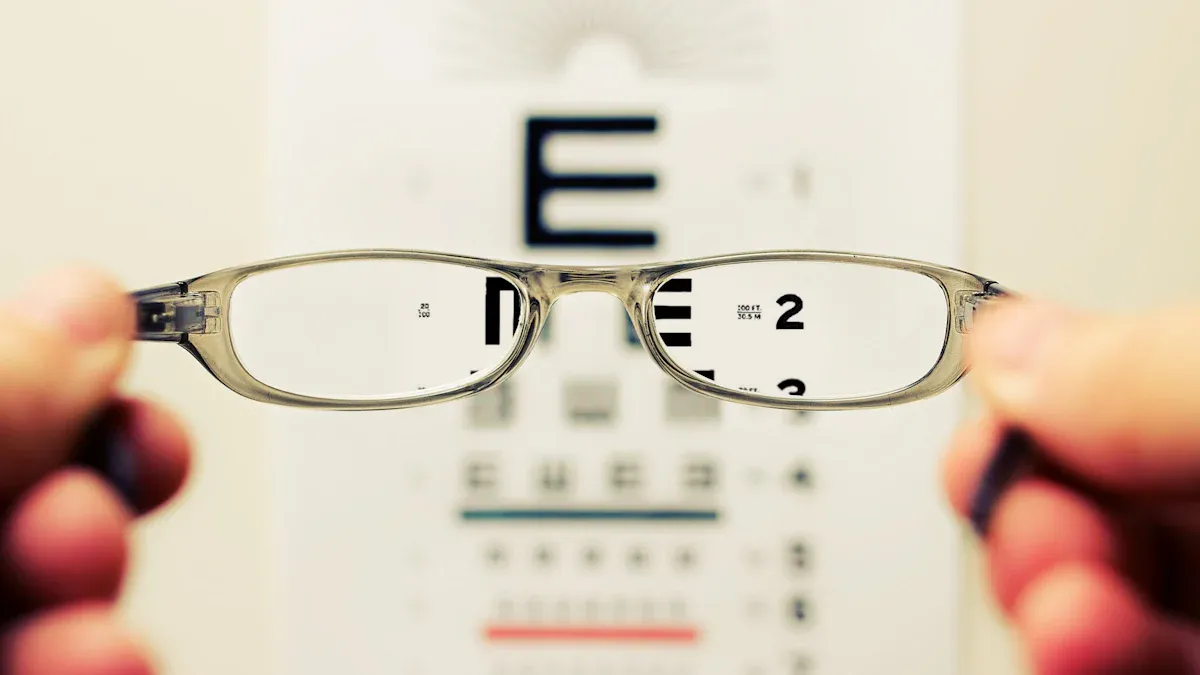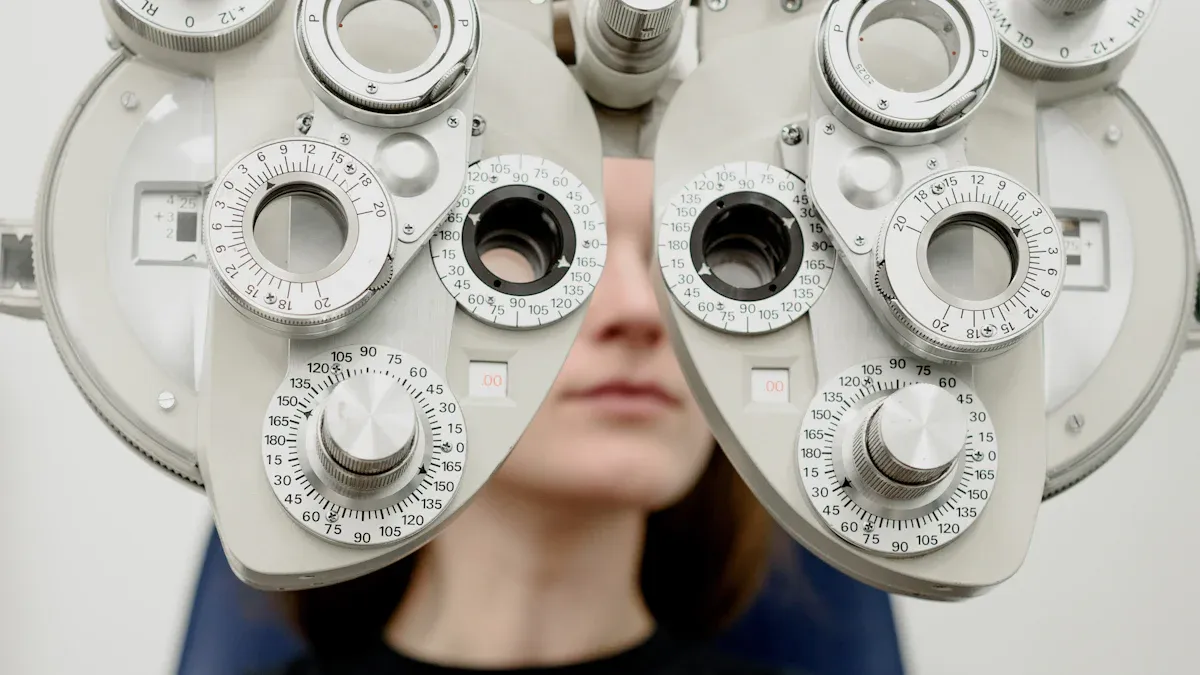
Your glasses prescription contains important details about your lenses. Approximately 70 per cent of adults require vision correction. Most individuals begin to need it between the ages of 18 and 21. Prolonged screen use and the natural ageing process often indicate that you need glasses. You may also need to read your prescription or buy prescription glasses online.
Key Takeaways
Knowing terms like SPH, CYL, and PD helps you pick lenses for your eyes.
After an eye test, you can get your glasses prescription to buy glasses anywhere.
Eye tests are important to find vision changes and keep your prescription correct for clear sight.
Key Terms and Symbols to Read Your Prescription

Knowing the terms and symbols on your glasses prescription is important. It helps you get the right lenses for your eyes. Below are simple explanations of the most common terms.
SPH (Sphere)
SPH shows the lens strength needed to fix your vision. It tells how much power your lenses need for nearsightedness or farsightedness. A positive SPH means you are farsighted. A negative SPH means you are nearsighted.
SPH Value Range |
Meaning |
|---|---|
0.00 |
No correction needed |
-20.00 |
Strongest correction for myopia |
+20.00 |
Strongest correction for hyperopia |
Most SPH values are between these numbers. If your SPH is near zero, you only need mild correction.
CYL (Cylinder)
CYL shows the lens power needed to fix astigmatism. Astigmatism happens when the eye's shape causes blurry vision. About one in three people have it. If no CYL is listed, you do not have astigmatism.
AXIS
AXIS works with CYL to fix astigmatism. It shows the angle of lens correction in degrees, from 1 to 180. This number ensures the lens matches your eye's shape.
PRISM and BASE
PRISM and BASE are less common but very important for some people. They fix double vision by aligning images from both eyes. These values must be accurate. Wrong settings can cause discomfort, like dizziness or imbalance. Opticians ensure these values are correct for your comfort.
ADD (Addition)
ADD is extra lens power for reading or close-up work. It is often in prescriptions for bifocal or progressive lenses. It helps you see nearby objects clearly, like books or screens.
PD (Pupillary Distance)
PD measures the space between your pupils in millimetres. This ensures lenses are placed correctly in your glasses. Proper placement is key for clear and comfortable vision.
'+' and '-' Signs
The '+' and '-' signs show if you are farsighted or nearsighted. A '+' means you need help seeing close objects. A '-' means you need help seeing far objects. The numbers after these signs show lens strength in diopters. For example, -1.00 means mild nearsightedness, while -4.25 means stronger correction.
Around 75% of adults use vision correction, and 64% wear glasses. Knowing these symbols helps you choose the right glasses and lenses for your needs.
Understanding Prescriptions for Each Eye
OD and OS (Right Eye and Left Eye)
On your glasses prescription, you will see OD and OS. These are Latin abbreviations. OD means "oculus dexter", or your right eye. OS means "oculus sinister", or your left eye. Eye doctors use these terms to show measurements for each eye.
Each eye might need different lenses. For example, your right eye could need stronger lenses for nearsightedness. Your left eye might only need a small correction. Knowing these terms helps you read your prescription and match the values to each eye.
Tip: If you see OU on your prescription, it means "oculus uterque", which is for both eyes.
Why Eyes Have Different Prescriptions
It is normal for each eye to need a different prescription. Eyes can have different shapes or focusing abilities. One eye might be more nearsighted or farsighted than the other. Astigmatism, which changes the eye's curve, can also vary between eyes.
Your brain helps your eyes work together. It combines images from both eyes into one clear picture. If one eye is weaker, your brain depends more on the stronger eye. This is why your optometrist adjusts the prescription for each eye separately.
By learning why prescriptions differ, you can see why accurate measurements matter. When reading your prescription, check the values for each eye. This ensures your glasses correct your vision properly.
How to Get Your Glasses Prescription
Asking Your Optometrist for a Copy
To get your glasses prescription, you need an eye test. Optometrists use different tests to find the right lenses for you. These tests make sure your glasses fit your vision needs. Here’s what happens during an eye test:
Visual Acuity Test: Checks how clearly you see letters on a chart.
Retinoscopy: Uses light to check how your eyes bend it.
Autorefractor: Gives a starting prescription by studying light in your eyes.
Subjective Refraction: Adjusts your prescription based on what you see best.
Near Vision Testing: Tests how well you see close objects, especially if over 40.
Binocular Vision Testing: Looks at how your eyes work together as a pair.
Pupil Testing: Checks how your pupils react to light for brain health.
Eye Health Check: Reviews your eye health with special tools.
After these tests, your optometrist gives you your prescription. If they don’t, you can ask for it. This paper lets you buy glasses anywhere, even online at places like Phifinery.
Your Right to Get Your Prescription
You have the right to get your glasses prescription right after your test. This lets you shop for glasses freely. Here’s a quick guide to your rights:
Rule |
Explanation |
|---|---|
Optometrists must give your prescription after the test. |
|
No Pressure |
They cannot force you to buy glasses from their shop. |
Fair Practice |
Not giving your prescription is unfair and stops price comparison. |
Knowing your rights helps you choose the best glasses for you. If there’s a problem, remind your optometrist of these rules. Online shops like Phifinery make using your prescription simple and convenient.
Steps to Take When Your Prescription Changes
Spotting Signs You Need a New Prescription
Your glasses might need updating if your vision changes or feels uncomfortable. Watching for these signs helps keep your eyesight clear and comfortable. Here are some common clues:
Blurry vision: Things that were clear now look fuzzy.
Frequent headaches: Old lenses can strain your eyes, causing headaches after reading or screen time.
Eye fatigue: Tired or dry eyes by evening may mean your lenses aren’t right anymore.
Night driving troubles: Glare or poor vision at night might mean your prescription needs changing.
Double vision: Seeing two images instead of one shows your lenses aren’t working well.
Other hints include tilting your head to see better, rubbing your eyes often, or holding books too close. Studies show regular eye tests can find prescription changes even if you don’t notice problems. One study found 58% of people without symptoms still needed updates to their glasses.
Adjusting to Your New Prescription
After getting a new prescription, follow these steps to get used to your updated lenses:
Wear your glasses daily: Start with short times, like an hour, then wear them longer. This helps your brain adjust to the lenses.
Expect small discomforts: Mild headaches or dizziness are normal at first and usually go away in days.
Practise looking through lenses: If you have bifocal or progressive lenses, practise using different parts for near and far objects.
Check the fit: Make sure your glasses sit well on your face. Badly fitting glasses can hurt or blur your vision. Visit an optician if they need fixing.
Watch for problems: Notice if blurriness or discomfort lasts. If it doesn’t improve in a week, ask your optician for help.
By spotting signs early and following these steps, your glasses will give you clear vision and comfort. Regular eye tests and caring for your lenses will keep your eyes healthy over time.
Knowing your glasses prescription helps you choose the right lenses. Learning the terms ensures your glasses suit your vision needs. A study of 13,795 students found only 46% knew they had short-sightedness, and just 15% wore glasses. Regular check-ups increase awareness and proper use.
Eye experts say understanding prescriptions improves results. 96% reported better comfort, and 84% saw good fitting success. Regular eye tests keep your prescription correct and your vision clear.
FAQ
What does "Plano" mean on a prescription?
"Plano" shows no lens power is needed. It is written as "PL" or "0.00". This means no correction is required for that eye.
Can I use my glasses prescription for contact lenses?
No, you cannot use a glasses prescription for contact lenses. Contact lenses need extra details like base curve and size to fit correctly.
Why do prescriptions expire?
Prescriptions expire to ensure your lenses suit your vision now. Regular eye tests find changes and keep your eyes healthy.
Tip: Always check when your prescription expires before buying new glasses! 🕶️






